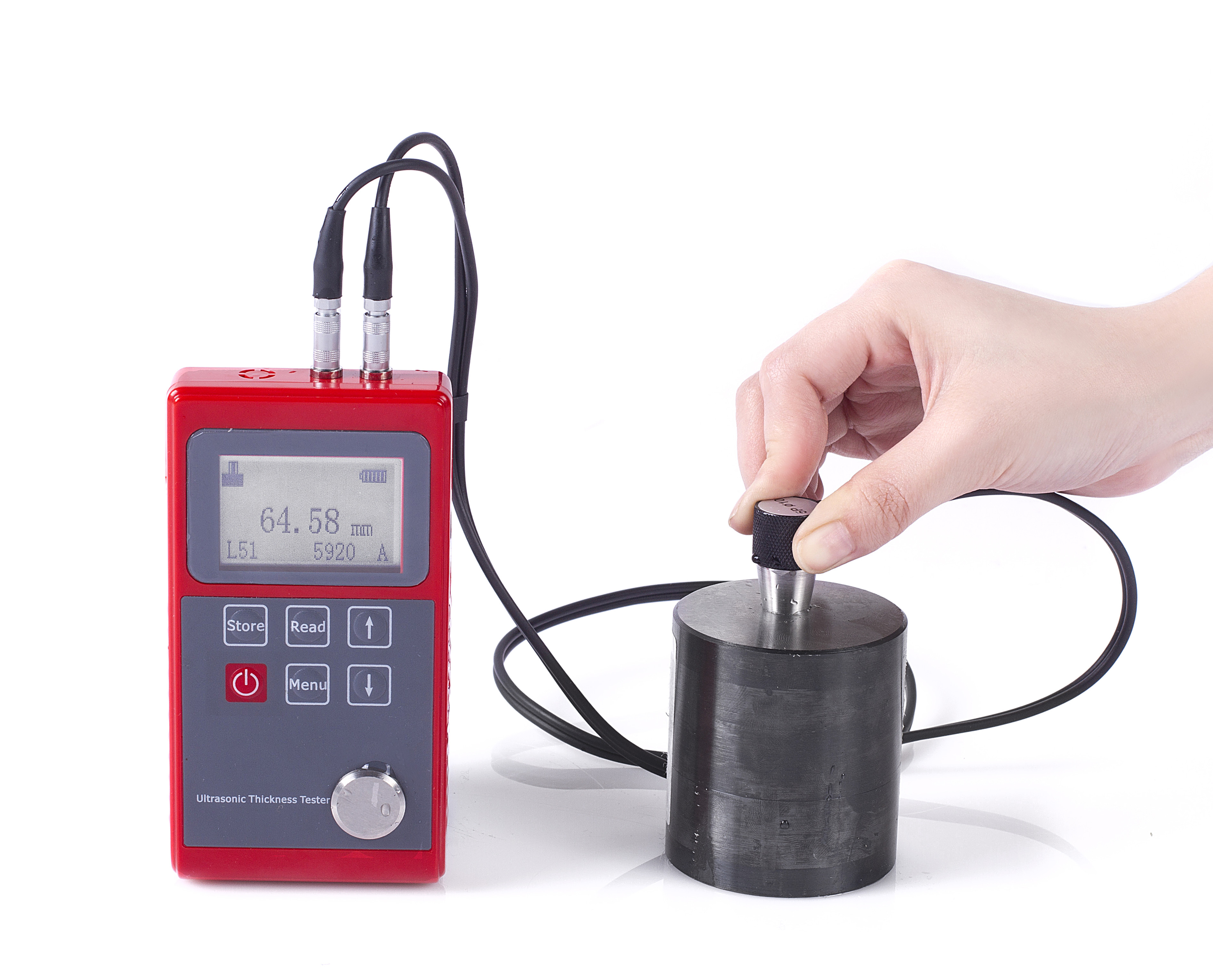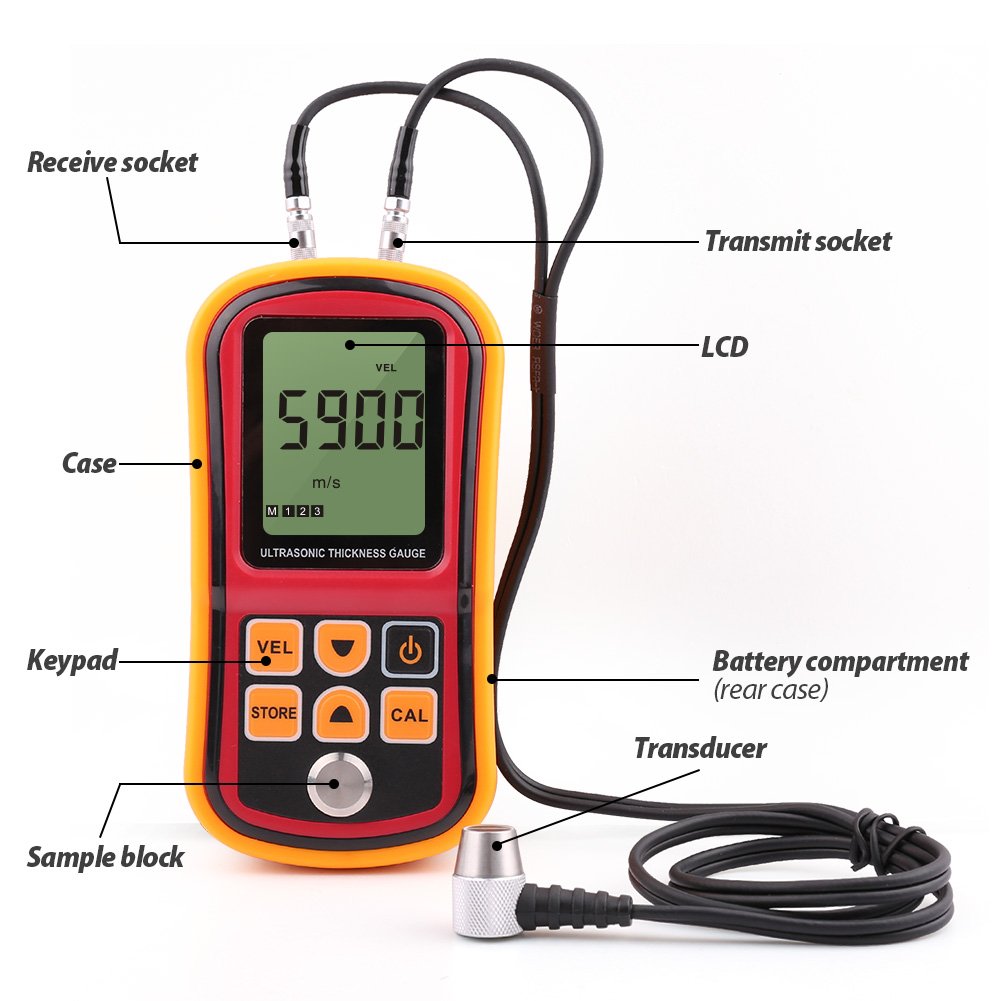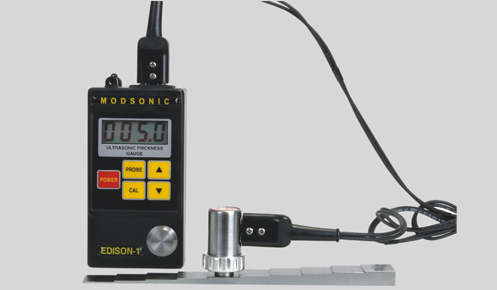Table Of Contents
- Introduction
- Mechanism of Ultrasonic Thickness Gauges
- Non-destructive Testing Procedure using Ultrasonic Thickness Testing Equipment
- Advantages and Disadvantages of Ultrasonic Transducer Gauges
- Applications of Ultrasonic Thickness Gauges
- Conclusion
- Key Takeaways
Introduction
In 2012, a potentially catastrophic industrial accident was narrowly averted at the Chevron Richmond Refinery in California, thanks to the crucial role played by ultrasonic thickness gauges.
This incident unfolded within the refinery's crude oil processing unit, where years of corrosion and degradation had taken a toll on the integrity of its piping systems.
Without timely intervention, this deterioration could have led to a devastating rupture of a critical pipeline, resulting in a massive fire and explosion.
During a routine inspection, the maintenance team employed ultrasonic thickness gauges, sophisticated instruments that use high-frequency sound waves, to assess the condition of these pipes.
These specialized gauges operate on a simple yet powerful principle: they emit high-frequency sound waves into the material, and by measuring the time it takes for the echoes to return, they accurately determine the thickness of the material.
This Non-destructive Testing Technique has a fascinating history. It originated during World War II when scientists and engineers developed Ultrasonic Testing to detect flaws in metals used in military aircraft.
Over time, this technology has evolved, becoming increasingly refined and versatile, and has found applications in various industries, including oil and gas.
The discovery of dangerously thin pipe walls prompted immediate action, including the shutdown of the affected section of the refinery for emergency repairs and maintenance.
This incident serves as a real-life testament to the invaluable role that ultrasonic gauges play in industrial safety.
By providing early warnings of structural deterioration through precise thickness measurements, these gauges help prevent accidents, protect workers, and safeguard the environment in high-risk industrial settings.

Mechanism of Ultrasonic Thickness Gauges
Ultrasonic Thickness Gauges, often referred to as UT gauges or ultrasonic thickness meters, are precision instruments used to measure the thickness of materials, primarily metals, without causing any damage to the material itself.
These gauges operate on the principle of sound wave propagation and reflection.
Ultrasonic thickness gauges function by emitting high-frequency sound waves into a material through a Transducer, precisely measuring the time it takes for these waves to travel through the material and return as echoes.
Using the known speed of sound in the material, the gauge calculates the material's thickness.
This widely applied Non-destructive Testing Method is essential for assessing material thickness, identifying corrosion, and verifying structural integrity in diverse industries.
1. Sound Wave Generation
- Ultrasonic Thickness Gauges generate high-frequency sound waves (typically 1 to 10 megahertz) using a piezoelectric crystal.
2. Transducer and Coupling
- A Transducer directs the sound waves towards the material being tested.
- A couplant (gel or grease) is applied to ensure efficient sound wave transmission.
3. Sound Wave Propagation
- Sound waves travel through the material until they encounter a boundary or the opposite surface.
- At each interface, including the initial surface and the back wall of the material, sound waves partially reflect.
4. Echo Detection
- The gauge contains a receiver to detect echoes or reflected sound waves.
- The time it takes for these echoes to return is precisely measured.
5. Thickness Calculation
- The gauge calculates material thickness by measuring the time interval between sound pulse emission and echo reception.
- The formula for thickness calculation is:
* Thickness = (Speed of Sound × Time Interval) / 2 (division by 2 accounts for the round trip).
6. Measuring Range
- The measuring range varies based on the gauge model and design.
- It typically spans from fractions of a millimeter (for thin materials) to several centimeters or even inches (for thicker materials).
- Specific measuring range details are provided in the gauge's specifications or user manual.
7. Display and Data Output
- The gauge displays the calculated thickness on its screen.
- Some models can store and output data for further analysis or documentation.
8. Calibration
- Calibration ensures gauge accuracy and involves setting it using a reference material of known thickness.
- Ultrasonic Thickness Gauges are widely used in various industries, including manufacturing, aerospace, oil and gas, and construction, for measuring the thickness of pipes, tanks, Pressure Vessels, and other structural components.
- They provide Non-destructive Testing (NDT) capabilities, allowing for the assessment of material integrity and the detection of corrosion or thinning in critical components, contributing significantly to safety and quality control.

Non-destructive Testing Procedure using Ultrasonic Thickness Testing Equipment
The step-by-step procedure for performing Non-destructive Testing (NDT) using an ultrasonic thickness gauge is as follows:
1. Calibration
- Begin by selecting a calibration block or reference material with a known thickness within your expected measurement range.
- Place the calibration block on a stable surface, ensuring it is perpendicular to the transducer.
- Apply couplant for proper contact.
- Perform zero calibration to account for any instrument circuitry delay.
- Set the gauge to the appropriate velocity of sound for the material.
- Trigger the gauge and record its measurement for the known thickness of the calibration block.
- Adjust the gauge's calibration settings until it matches the known thickness.
- Verify the accuracy of the calibration by re-measuring the calibration block.
- Document the calibration procedure, including settings and measurements, for reference during NDT Inspections.
2. Preparation
- Ensure that the Ultrasonic Thickness Gauges are in good working condition and calibrated properly. Follow the manufacturer's guidelines for calibration.
- Wear appropriate personal protective equipment (PPE), such as safety goggles, gloves, and hearing protection, as required by your workplace safety protocols.
3. Surface Preparation
- Clean the surface of the material to be tested thoroughly, removing any dirt, rust, or coatings.
- A clean surface ensures good sound wave Transmission and accurate measurements.
- Apply a complaint, typically a gel or grease, to ensure proper contact between the Transducer and the material.
4. Transducer Placement
- Position the Transducer (probe) on the surface of the material at the measurement location.
- Ensure that it is perpendicular to the surface for accurate readings.
- Apply gentle pressure to ensure good coupling between the transducer and the material.
5. Sound Wave Emission
- Trigger the Ultrasonic Thickness Gauges to emit a high-frequency sound wave pulse into the material.
- The sound wave travels through the material and encounters boundaries or interfaces, including the front and back surfaces.
6. Echo Detection
- The Ultrasonic Thickness Gauges's receiver detects the echoes or reflected sound waves from the interfaces.
- The time between the emission of the sound pulse and the reception of the echo is precisely measured.
7. Thickness Calculation
- Using the measured time interval and the known speed of sound in the material, the gauge calculates the thickness of the material.
- The formula for thickness calculation is Thickness = (Speed of Sound × Time Interval) / 2, where the division by 2 accounts for the round trip of the sound wave.
8. Recording and Documentation
- Record the measured thickness value in your inspection log or datasheet.
- Include relevant information such as the date, location, and any additional notes about the measurement.
9. Interpretation
- Compare the measured thickness to the required or expected thickness values for the material.
- Assess whether the material meets the specified thickness requirements.
- Pay attention to any significant deviations from expected values, as these could indicate Corrosion, thinning, or defects in the material.
10. Repeat Measurements
- Depending on the inspection requirements and standards, you may need to take multiple measurements at different locations on the material or structure.
- Ensure that you follow a systematic approach, covering all critical areas.
11. Analysis and Reporting
- Analyze the collected data to determine the overall condition of the material.
- Prepare a comprehensive inspection report that includes measurements, findings, and any recommended actions (e.g., maintenance or repairs).
12. Safety and Cleanup
- After completing the inspection, safely turn off the Ultrasonic Thickness Gauges and store them appropriately.
- Clean the transducer and remove any remaining couplant from the material.
13. Follow-Up Actions
- Based on the inspection results, take appropriate follow-up actions, which may include maintenance, repairs, or further testing, as required to ensure the structural integrity of the material or component.
Performing NDT procedures using Ultrasonic Thickness Gauges requires attention to detail, proper technique, and adherence to safety guidelines.
Accurate measurements and thorough reporting are essential for maintaining the safety and quality of structures and materials in various industries.

Advantages and Disadvantages of Ultrasonic Transducer Gauges
The advantages and disadvantages of Ultrasonic Thickness Gauges are as follows:
Ultrasonic Transducer gauges offer non-destructive testing capabilities, allowing measurements to be taken without causing any damage to the material being inspected.
Achieving accurate results requires a skilled operator who understands the Principles of Ultrasonic Testing and can properly use the equipment.
They provide highly accurate thickness measurements, making them suitable for applications where precision is critical, such as quality control and safety assessments.
Ultrasonic Testing may not be suitable for materials with irregular surfaces, highly porous materials, or materials that do not conduct sound waves effectively.
These gauges have a broad measuring range, from thin materials, often a fraction of a millimeter, to thicker materials measuring several centimeters or more.
The accuracy of measurements can be affected by the surface condition, including roughness, curvature, and coatings. Proper surface preparation is essential.
They can be used on various materials, including metals, plastics, composites, and ceramics, making them versatile tools for different industries.
In some cases, access to both sides of the material may be required for the transducer to emit and receive sound waves effectively, limiting its use in confined spaces.
Many Ultrasonic Transducer gauges are portable and handheld, allowing for ease of use in the field or on-site inspections.
Ultrasonic transducer gauges require regular calibration to maintain accuracy, and this can be a time-consuming process.
They provide real-time measurements, enabling immediate assessment and decision-making during inspections.
High-quality Ultrasonic Thickness Gauges can be relatively expensive, especially those with advanced features and capabilities.
While some surface preparation is necessary, it is generally minimal compared to other testing methods, making inspections more efficient.
Extreme temperatures, high levels of humidity, or harsh environmental conditions can affect the performance of ultrasonic gauges.
Applications of Ultrasonic Thickness Gauges
The applications of Ultrasonic Transducer Testing gauges are as follows:
- Industrial Maintenance and Inspection
Ultrasonic Thickness Gauges are widely used for industrial maintenance and inspection to measure the thickness of materials such as pipelines, storage tanks, Pressure Vessels, and structural components.
They ensure that these assets meet safety and quality standards, preventing issues like corrosion and material degradation.
- Oil and Gas Industry
In the Oil and Gas Sector, ultrasonic thickness gauges play a crucial role in assessing the thickness of pipes, Pipelines, and offshore structures.
They help identify corrosion, erosion, or material thinning, ensuring the integrity of critical infrastructure.
- Maritime Industry
Ultrasonic thickness measurement is vital for ship maintenance and safety.
These gauges are used to inspect hulls, bulkheads, and marine structures for any signs of wear and tear, ensuring seaworthiness and compliance with regulations.
- Aerospace Industry
Ultrasonic Thickness testing equipment is employed in the Aerospace industry to evaluate the thickness of aircraft components, such as wings, fuselages, and engine parts.
It aids in identifying any structural weaknesses and ensuring aircraft safety.
- Manufacturing and Quality Control
Ultrasonic Thickness Gauges are used in manufacturing processes to monitor the thickness of materials during production.
They help maintain consistent quality and adherence to specifications in industries like metal fabrication and automotive manufacturing.
- Construction
In the construction industry, Ultrasonic Thickness Gauges are used to assess the thickness of materials like concrete and steel in buildings, bridges, and infrastructure projects, ensuring structural integrity and compliance with design specifications.
- Chemical and Petrochemical Plants
Ultrasonic Steel Thickness gauges are employed in chemical and petrochemical plants to inspect the thickness of pipes and equipment that handle corrosive substances.
They aid in preventing leaks and ensuring the safety of these facilities.
- Power Generation
Ultrasonic wall thickness gauges are utilized in Power Plants, including nuclear and fossil fuel facilities, to assess the thickness of boiler tubes, Pressure Vessels, and heat exchangers.
This helps prevent failures and ensures continuous power generation.
- Automotive Industry
Ultrasonic Testing thickness measurement is used in the Automotive Industry to assess the thickness of vehicle components like engine parts, chassis, and body panels, ensuring safety and quality standards are met.
- Non-Destructive Testing (NDT)
Ultrasonic Thickness Gauges are essential tools in the field of NDT, enabling inspectors to assess the thickness of materials without causing damage.
This is crucial for evaluating the structural integrity of various objects and components.
- Civil Engineering
In civil engineering projects, ultrasonic thickness meters are used to measure the thickness of materials in construction elements like bridges, tunnels, and dams, ensuring their durability and safety over time.
Conclusion
Ultrasonic Thickness Gauges, known by various names such as ultrasonic thickness measurement devices, meters, and testing equipment, stand as indispensable tools across a wide spectrum of industries.
From safeguarding critical infrastructure in the Oil and Gas Sector to ensuring the structural integrity of aircraft components, these devices have consistently delivered accurate and non-destructive thickness measurements.
The future of Ultrasonic Thickness Gauge applications appears promising.
As technology advances, we can anticipate even more innovative uses, increased automation, and enhanced data analysis capabilities.
Moreover, the Non-destructive Testing (NDT) industry is poised to benefit immensely from these developments, as ultrasonic thickness gauges continue to be at the forefront of ensuring safety, quality, and longevity in a rapidly evolving industrial landscape.
Their adaptability, precision, and non-invasive nature make them valuable assets in our pursuit of safer and more resilient structures and materials.
Key Takeaways
- Ultrasonic thickness gauges are versatile instruments used for Non-destructive Testing (NDT) to measure material thickness accurately without causing damage.
- They play a critical role in industries like maritime, Oil and Gas Industry, and manufacturing, ensuring safety, structural integrity, and product quality.
References
1. LEEB Instrument
2. Modsonic
3. Willrich Precision Instruments
4. Olympus IMS
5. Huatec Group Corporation










